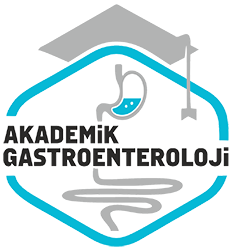Aralik 2015
Hepatit C’li hastalarda ortalama trombosit hacmi ve nötrofil-lenfosit oraninin anlamli fibrozis tanisinda etkinliği
The efficacy of mean platelet volume and neutrophil-lymphocyte ratio in the diagnosis of significiant fibrosis in patients with hepatitis C
- Ana Sayfa
- Sayılar
- Aralik 2015
- Hepatit C’li hastalarda ortalama trombosit hacmi ve nötrofil-lenfosit oraninin anlamli fibrozis tanisinda etkinliği...
Özet
Giriş ve Amaç: Hepatit C virüsü enfeksiyonlu hastalarda fibrozis derecelendirmesi için altin standart olan perkütan karaciger biyopsi yerine kullanilabilecek non-invaziv fibrozis modelleri geliştirilmektedir. Ortalama trombosit hacmi ve nötrofil-lenfosit orani karacigeri ilgilendiren birçok hastalıkta değerlendirilmıştır. Çalışmamızin amacı tam kan sayimindan elde edilen ortalama trombosit hacmi ve nötrofil-lenfosit oraninin hepatit C virüsü tanısı olan hastalarda non-invaziv fibrozis modeli olarak kullanilabilirligini değerlendirmektir. Gereç ve Yöntem: Haziran 2007-Subat 2015 yıllari arasında hepatoloji poliklinigimizde takipli Hastaların verileri retrospektif olarak incelendi. Toplam 101 hasta çalışmaya dahil edildi. Ortalama trombosit hacmi ve nötrofil-lenfosit orani değerleri, biyopsi öncesi hastalardan alinan kan örneğine göre değerlendirildi. Hastaların fibrozis derecesi Ishak sistemine göre siniflandirildi (F0-1; Fibrozis yok-hafif ve F≥ 2; anlamli fibrozis). Ortalama trombosit hacmi ve nötrofil-lenfosit oraninin tanısal basarisi daha önce tanımlanmis olan non-invaziv modellerle (aspartat aminotransferaz-platelet ratio index ve FIB-4) karsilastirildi. Bulgular: Fibrozis derecesi ile ortalama trombosit hacmi arasında anlamli korelasyon saptanırken nötrofil-lenfosit orani ile fibrozis derecesi arasında korelasyon görülmedi. F0-1 hasta grubunda, F ≥ 2 hasta grubuna göre ortalama trombosit hacmi anlamli olarak düşüktü (sırası ile 8.2 vs. 9.1; p=0.001). Ancak nötrofil-lenfosit orani değeri iki grup arasında farkli degildi (sırası ile 1,6 vs.1.7; p>0.05). Ortalama trombosit hacminin 8.05 cut-off değerinde anlamli fibrozisi ayirmadaki sensitivite ve spesivitesi sırası %80.9 ve %44.4 ölçüldü (p<0.001). Aspartat aminotransferaz-platelet ratio index ve FIB-4 ile karsilastirildiginda ortalama trombosit hacminin tanısal basarisi bu modellere benzerdi ancak nötrofil-lenfosit oraninin anlamli fibrozisi ayirmada etkinligi saptanmadi. Tartisma: Ek bir maliyet getirmeyen ve kolay ulasilabilen ortalama trombosit hacminin, hepatit C’li hastalarda anlamli fibrozisi öngörmede non-invaziv bir metod olarak kullanilabilecegi görüldü. Ancak nötrofil-lenfosit oraninin anlamli fibrozis ayiriminda yararli olamayacagi saptandi.
Abstract
Background and Aims: In patients infected with the hepatitis C virus, non-invasive fibrosis models are under development to replace percutaneous liver biopsy, the current gold standard for fibrosis (F) assessment. We analyzed mean platelet volume and neutrophil-lymphocyte ratio for several liver related illnesses to evaluate the usefulness of mean platelet volume and neutrophil-lymphocyte ratio, which are obtained by full blood count, as a non-invasive fibrosis model for patients diagnosed with the hepatitis C virus. Materials and Method: We analyzed the data of patients followed by our department between June 2007 and February 2015. A total of 101 patients were included in the study. Mean platelet volume and neutrophil-lymphocyte ratio values were taken in accordance with blood samples obtained before biopsy. The fibrosis levels of patients were classified according to the Ishak system (fibrosis 0-1, no/mild fibrosis; and fibrosis ≥ 2, significant fibrosis). Diagnostic success of mean platelet volume and neutrophil-lymphocyte ratio were compared with pre-defined non-invasive models (APRI and FIB-4). Results: There was significant correlation between fibrosis level and mean platelet volume, but no correlation between neutrophil-lymphocyte ratio and fibrosis assessment. The mean platelet volume was significantly lower in the fibrosis 0-1 patient group, in comparison to fibrosis ≥ 2 patient group, respectively (8.2 vs. 9.1; p=0.001). However, neutrophil-lymphocyte ratio values were not different for the two groups, respectively (1.6 vs.1.7; p>0.05). At 8.05 cut-off value of mean platelet volume for the diagnosis of significant fibrosis, sensitivity and specificity were 80.9% and 44.4% (p<0.001), respectively. In comparison to APRI and FIB-4, diagnosis success of mean platelet volume was similar to these models, but no efficiency of neutrophil-lymphocyte ratio was found in the diagnosis of significant fibrosis. Conclusion: With easy access and no additional cost, mean platelet volume was found to be suitable as a non-invasive method for the diagnosis of significant fibrosis in hepatitis C virus patients. However, neutrophil-lymphocyte ratio was found to be incompatible for use in the diagnosis of significant fibrosis.



